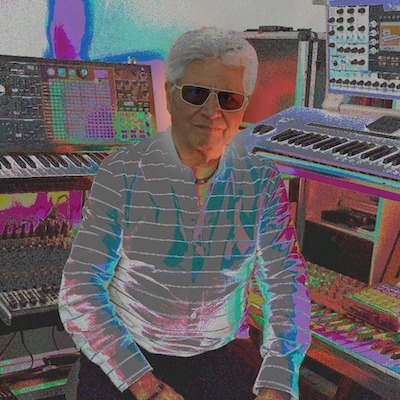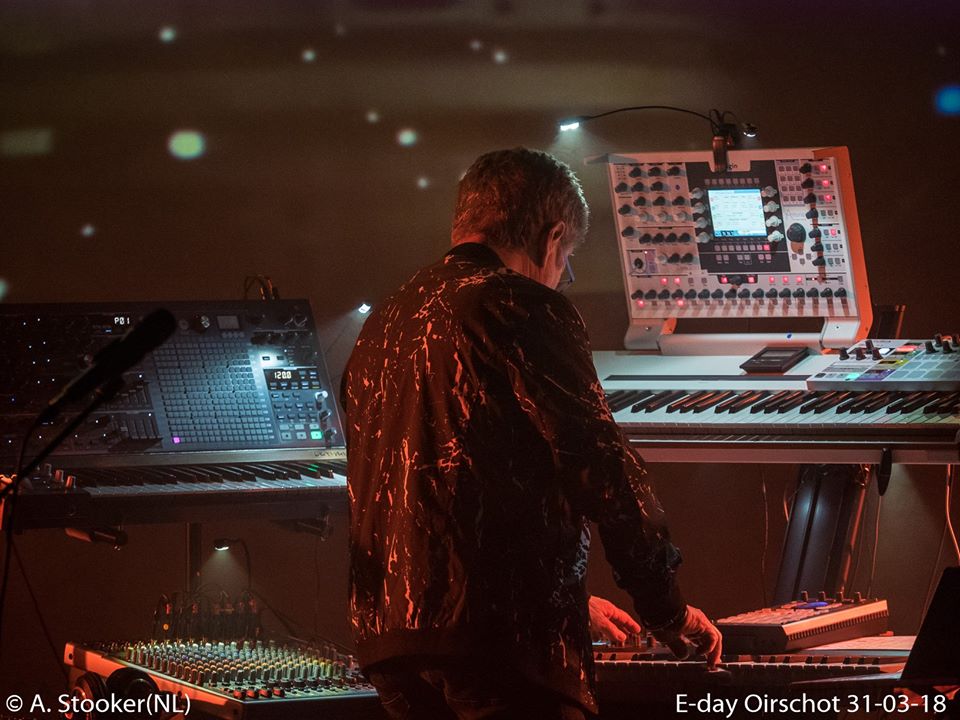 
|
||||
|
|
ZANOV |
|||
|
The Chaos Islands Interview
Zanov: In France, we are in the de-confinement phase with constraints that are gradually decreasing. It's not too difficult for me because I'm used to being confined voluntarily in my home studio. Chaos Islands is a concept album about the “Chaos Theory”. Chaos Theory is a science, which has for object the study of the nonlinear phenomena governed by simple and deterministic laws, whose behavior under certain conditions becomes unpredictable. It is one of the 3 scientific revolutions of the 20th century with the theory of relativity and quantum theory. It makes it possible to conceive how life and all that exists could have emerged from almost nothing. Chaos Theory has been guiding my life for very long time and has always been reflected in my music. Chaos theory is not only an inspiration for my music… it gives me directions for the creation of my sounds and my musical structures. I create a piece of music like a slice of life that I perceive with reference to the theory of chaos. The phases of stability and phases of chaos, predictable or unpredictable sound events, critical events which make the song evolve from one phase to another, is called a bifurcation in chaos theory. Order which interacts with disorder is called the edge of chaos. Phases which attract us and which reproduce without being completely identical is called strange attractors in chaos theory and all this at different scales in sound structures is called fractals in chaos theory. But the important thing is everything that emerges from the end result: the music, the pleasure and the emotions it brings. mwe3: Tell us about the album design. I noticed that the artwork includes an imaginary game mixing or matching the different Chaos Islands themes. Was the same graphics person involved for all the art? Was the artist Guillaume Diard? How does the design fit in with your sonic concepts? Zanov: I designed the concept and the structure of the album cover and created the image of the front cover. Guilaume Diard made it. The image of the front cover is very important to me and should reflect the music of the album… the balance between order and chaos, large variety of colors, 3D sensation, surprises. Technically, the image is an excerpt from the video clip I made with i-Movie using video keying techniques between 3D fractals and VJ sets and then processed with GIMP. mwe3: The lead off track “Edge Of Chaos Island” is like an overture of sorts. Did you set out to start off with an anthem like introduction to the album?
mwe3: You say track 2, “Inception Island” was inspired by the film Inception. In what ways does the music reflect the film? Is that the film with DiCaprio? Are you inspired by film soundtracks? What are some of your favorite movie soundtrack composers? Zanov: I like very much the concept of the film Inception, the one with Leonardo DiCaprio, with this idea of fractal dreams and fractal time. The fractals are an important feature of the chaos theory, which captures the infinite complexity of the nature. I like the soundtrack by Hans Zimmer but I asked myself what music should I do to make you feel these fractal dreams and times with the end in limbo? This is how “Inception Island” was created. mwe3: The track “Strange Attractor Island” is more low-key electronica. You draw the comparison to an invisible fractal structure. Is this track invisible music to blend into the world? There is a wonderful section with flanged sounding keyboards. What keyboards are featured on “Strange Attractor Island”? Zanov: “Strange Attractor Island” is a kind of spheroidal structure with minimum rhythm allowing for a focus on different visions of the melody. It was inspired by the strange attractor discovered by Edward Lorentz, one of the pioneers of chaos theory where the system remains on a fractal structure, which repeats itself indefinitely but is never exactly the same. The changes may be unnoticeable, but at the end the result may be completely different. mwe3: How about the synths you used on the Chaos Islands album? Tell us about the Arturia synths and the Access Virus TI. Do you blend different synths on the same track and do you still have your original synths and keyboards from the 1970s?
mwe3: “Three Body Island” starts off slow and builds into a Shadows / Vangelis inspired instrumental. Could you cite other directions and influences on this track and what inspired the title? It’s very dreamy. Zanov: The idea behind "Three Body Islands" was to reflect the problem of the three bodies for which Henri Poincaré, who was a French mathematician at the end of the 19th century, demonstrated… that the interaction between three bodies which attract each other leads to chaos, which means unpredictable. results. Each body is represented by a melody, and you can hear that the timbral characteristics of a melody are influenced by the timbre of the previous ones, leading in the end to a non-melodic sound representing chaos. But at the same time, I intended that it would be possible to be film music. mwe3: What can you tell us about “Phase Space Island”? Zanov: In chaos theory, a phase space is a space in which all the possible states of a system are represented and in which we can see the strange attractors. The idea that I had to translate into my music was to simultaneously play several melodies, vibrations, sounds and sequences in order to feel a wide variety of sounds at the same time and to make them evolve as if we were following an attractor that leads nowhere.
Zanov: The bifurcation in chaos theory is when a tiny difference can move the whole system toward completely different behavior. We have all experienced small events in our lives that have completely changed our future. For "Instability Island", I tried to keep a musical tension to make us feel that anything can happen and change the following. mwe3: There are some great electronic music artists on the 21st century scene. How would you compare the music makers of the late 1970s with musicians working in 2020? Zanov: In the 1970s, and even today for me, we were building all our sounds and bringing the sound matter to life, spending a lot of time realizing what we felt. Now, most electronic music is made with computer software, mainly Ableton Live, by sound loops and copy / paste techniques, often using sound libraries created by other people called sound designers. The consequence is that there is a gap here between the level of the sound material and the level of composition, which brings a limit to creativity and the expression of emotions. Even live performances are now pseudo live because the whole track is recorded on computer - audio or midi - and the performance is limited to making live modifications to what is recorded. The top artists using this technique are DJs, but you can forgive them because their music does not have the same purpose, they make people dance. Now we see emerging collaborative music via the Internet, music generated by a large amount of objects, music assisted by artificial intelligence, new EM instruments built with 3D printers, live music influenced by the audience - music generated by connected clothing. The place and the role of the musician is changing.
Zanov: How can order emerge from chaos? In my music, the phases of disorganized sound materials are multiple in my compositions and are part of my music. This is the chaotic part from which will emerge the order often represented by melodic lines and more regular sequences. The passages in the disorder zones allow you to get out by generating a different order and to change the musical composition, this is the edge of chaos. Too much order and everything is frozen and unattractive, too much disorder and it is random noise. In music, the balance and the evolution between order and disorder is a key point in the aesthetics and emotion perceived by the listener. Depending on our life course, our culture and our listening, our sensitivity goes towards more or less order or disorder, expected or unpredictable. mwe3: Now with the pandemic of 2020, what are you hopeful for? I keep thinking that the next two years will be very eventful as the Golden Age is supposedly coming in 2023 with Pluto finally moving out of Capricorn into Aquarius. Are you predicting many changes for the world and how does the music of Zanov fit into this era? Zanov: I have a scientific background and my mind is turned to the future, so let me conclude with a very long-term vision; Life is a change and no one can imagine how the world will change in the long-term as there will be phenomena beyond our consciousness. Most changes are now driven by scientific discoveries, although it takes time to reap benefits in our human society.
Visit Zanov Online at:
|
|
|||
|
||||

 Like a sonic apparition arising from the ashes of his late ‘70s albums, France’s preeminent synth maven, Zanov returned after many decades with Virtual Future (2014) and Open Worlds(2016). In 2020 Zanov returns with a kind of concept album called Chaos Islands. Conceived very much in the spirit of late 1970s French synthesizer music and as expected on the 7-track 49-minute Chaos Islands, Zanov draws on a bevy of vintage and new synthesizers that echo the moods of both Jean Michel Jarre and classic Tangerine Dream, brought into the 2020 era. The idea of using islands the titles, like “Chaos Island”, “Inception Island”, “Instability Island”, as the title themes is quite intriguing. More cerebral and less bombastic, on Chaos Islands Zanov really shines, bringing his sci-fi sounding instrumental music into a computerized and synthesized world of its own. Thanks to his expertise as an electronic music composer and synthesizer wizard, the album sounds like the sum of its parts, with each track bringing in something unique and magical. Chaos Islands brings New Age electronica alive and kicking into the 2020’s. With the CD featuring brilliant art by Guillaume Diard, Chaos Islands is a superbly written, recorded and detailed futuristic concept album that journeys to a sonically inviting world all its own.
Like a sonic apparition arising from the ashes of his late ‘70s albums, France’s preeminent synth maven, Zanov returned after many decades with Virtual Future (2014) and Open Worlds(2016). In 2020 Zanov returns with a kind of concept album called Chaos Islands. Conceived very much in the spirit of late 1970s French synthesizer music and as expected on the 7-track 49-minute Chaos Islands, Zanov draws on a bevy of vintage and new synthesizers that echo the moods of both Jean Michel Jarre and classic Tangerine Dream, brought into the 2020 era. The idea of using islands the titles, like “Chaos Island”, “Inception Island”, “Instability Island”, as the title themes is quite intriguing. More cerebral and less bombastic, on Chaos Islands Zanov really shines, bringing his sci-fi sounding instrumental music into a computerized and synthesized world of its own. Thanks to his expertise as an electronic music composer and synthesizer wizard, the album sounds like the sum of its parts, with each track bringing in something unique and magical. Chaos Islands brings New Age electronica alive and kicking into the 2020’s. With the CD featuring brilliant art by Guillaume Diard, Chaos Islands is a superbly written, recorded and detailed futuristic concept album that journeys to a sonically inviting world all its own. mwe3: Zanov, how are things in France? Is the virus still front and center news there? Your new album Chaos Islands seems like the perfect antidote to the chaos in the world today. Is it a concept album about world chaos?
mwe3: Zanov, how are things in France? Is the virus still front and center news there? Your new album Chaos Islands seems like the perfect antidote to the chaos in the world today. Is it a concept album about world chaos? Zanov: In fact, this album was created over a period of 2 years. I decided to put the tracks in the same order as they were composed to keep the evolution of my mind over this long period. "Edge of Chaos Islands" was the first one, composed in early 2018. The idea was to give a film music spirit with a structure that reflected more order than chaos. In the chaos theory, the truly creative changes and the big shifts occur right at the transition state between order and chaos, called the edge of chaos.
Zanov: In fact, this album was created over a period of 2 years. I decided to put the tracks in the same order as they were composed to keep the evolution of my mind over this long period. "Edge of Chaos Islands" was the first one, composed in early 2018. The idea was to give a film music spirit with a structure that reflected more order than chaos. In the chaos theory, the truly creative changes and the big shifts occur right at the transition state between order and chaos, called the edge of chaos. Zanov: When I compose, I pay attention to aesthetics, technique and emotion. To bring emotion, I do the whole plot of the song live, from start to finish using, all synths at the same time. It is then that I come to modify and complete the other sound structures by providing rigor and with attention to detail. My approach is that of the 1970s in the sense that I do not use current techniques of copying, pasting or loops. I make all my sounds and I bring my sound matter to life… I don't do meta-music. For all the tracks of this album, I used three synths; the Arturia Origin, the Access Virus TI and the Arturia MatrixBrute. I have nothing left from my old synths. The Origin brings me the visibility of the modular synths, even if it is through a screen. The Virus TI brings me a lot of sound possibilities but access is difficult. Both provide many functions in multimode, which allows access to several presets at the same time, in polyphony, in split keyboard. In addition, I use the MatrixBrute for the ease of its matrix and therefore for the sequencer.
Zanov: When I compose, I pay attention to aesthetics, technique and emotion. To bring emotion, I do the whole plot of the song live, from start to finish using, all synths at the same time. It is then that I come to modify and complete the other sound structures by providing rigor and with attention to detail. My approach is that of the 1970s in the sense that I do not use current techniques of copying, pasting or loops. I make all my sounds and I bring my sound matter to life… I don't do meta-music. For all the tracks of this album, I used three synths; the Arturia Origin, the Access Virus TI and the Arturia MatrixBrute. I have nothing left from my old synths. The Origin brings me the visibility of the modular synths, even if it is through a screen. The Virus TI brings me a lot of sound possibilities but access is difficult. Both provide many functions in multimode, which allows access to several presets at the same time, in polyphony, in split keyboard. In addition, I use the MatrixBrute for the ease of its matrix and therefore for the sequencer. mwe3: “Instability Island” is interesting. You speak about bifurcations leading to perpetual change. Can you further elucidate? What keyboards are you featuring on that track?
mwe3: “Instability Island” is interesting. You speak about bifurcations leading to perpetual change. Can you further elucidate? What keyboards are you featuring on that track? mwe3: Chaos Islands ends with “Emergence Island”. It’s the most majestic sounding track on the album. As you describe the “complex, beautiful and surprising structures” that emerge in form here. I think it’s my favorite track on the album.
mwe3: Chaos Islands ends with “Emergence Island”. It’s the most majestic sounding track on the album. As you describe the “complex, beautiful and surprising structures” that emerge in form here. I think it’s my favorite track on the album.